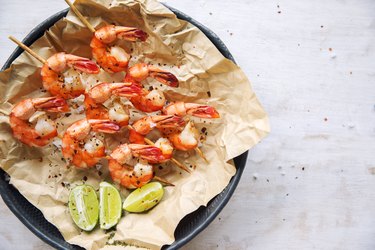
Do you have a bag of frozen shrimp in your freezer? Are you looking for the best way to reheat shrimp? Like other frozen, pre-cooked proteins, you can have a tasty shrimp dish on the table in no time.
Your Precooked Shrimp
Video of the Day
According to the Seafood Nutrition Partnership, seafood consumption is on the rise and more Americans are meeting the recommended two servings of seafood a week. While the type of seafood Americans eat vary, shrimp tops the list.
Video of the Day
Like other types of seafood, shrimp is low in calories and high in protein. According to the USDA, 3-ounces of frozen shrimp provides:
- 110 calories
- 22 grams of protein
- 2 grams of total fat
- 13 percent of the daily value (DV) for sodium
- 15 percent of the DV for iron
- 53 percent of the DV for cholesterol
Your frozen shrimp may meet more than half the daily value for cholesterol, but the current Dietary Guidelines no longer restricts your dietary cholesterol intake. According to a June 2018 review published in Nutrients, it's not the cholesterol in food that affects heart health, but the saturated fat. Shrimp isn't a significant source of saturated fat with zero grams per serving, according to the USDA.
However, when it comes to foods high in cholesterol, including shellfish like shrimp and eggs, moderation is still recommended.
Read more: Do Prawns Make a Healthy Meal?
Best Way to Reheat Shrimp
Your precooked shrimp may be convenient, but it still requires some effort when reheating. There's no one best way to reheat shrimp. However, whatever method you choose, make sure you reheat your shrimp until it reaches an internal temperature of 145 degrees Fahrenheit. This is the perfect temperature for killing any bacteria that may make you sick, according to North Carolina State University.
You can reheat your shrimp in the microwave, skillet or steamer. For microwave cooking, place your shrimp in a microwave-safe dish; then cover it and cook for one to two minutes.
While the microwave is convenient, it can reheat your shrimp unevenly, and you may want to check each shrimp to make sure it's fully reheated. Cooking your shrimp in a single layer in your microwave-safe dish may allow for more even heating.
The best way to reheat shrimp in your skillet is to first preheat your pan over medium heat and then heat your oil. Once the oil is hot, add your shrimp and cook for two to three minutes, or until heated to the proper temperature.
A steamer also works well for reheating your shrimp. Place your shrimp in a single layer on the bottom of your steamer basket and steam for two to three minutes.
Read more: How to Microwave Already-Cooked Shrimp
Frozen Precooked Shrimp Recipes
You can find a slew of frozen precooked shrimp recipes after a quick search on the internet. Depending on the recipe, your precooked shrimp may need to be thawed or reheated prior to adding it to the rest of the ingredients. To thaw your frozen shrimp, place them in the refrigerator overnight or run cold water over the frozen shrimp in a bowl in the sink.
Garlic butter shrimp is a tasty way to prepare your precooked frozen shrimp. Over medium heat, melt butter and add minced garlic and cook until the garlic is lightly browned, about three minutes. Then add your shrimp and saute until heated through, about two to three minutes. Take the garlic butter shrimp off the heat, toss with fresh dill and serve.
You can also toss your garlic butter shrimp with cooked linguine. Or if you're watching your carbs, mix it with zucchini noodles.
For taco Tuesday, add your favorite taco seasonings to the pan while you're reheating your frozen shrimp on the stove and serve with corn tortillas, shredded lettuce and your favorite pico de gallo.
- Seafood Nutrition Partnership: "News Update: U.S. Per Capita Seafood Consumption Up in 2017"
- USDA FoodData Central: "Frozen Shrimp"
- Nutrients: "Dietary Cholesterol and the Lack of Evidence in Cardiovascular Disease"
- North Carolina State University: "Frozen Shrimp: Ensuring Food Safety"
- Simply Healthy Family: "How to Reheat Shrimp: Three Easy Ways to Reheat Already Cooked Shrimp"